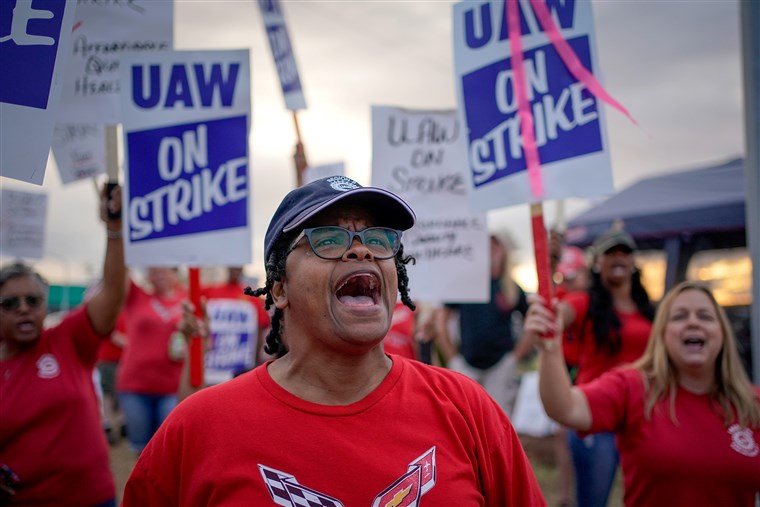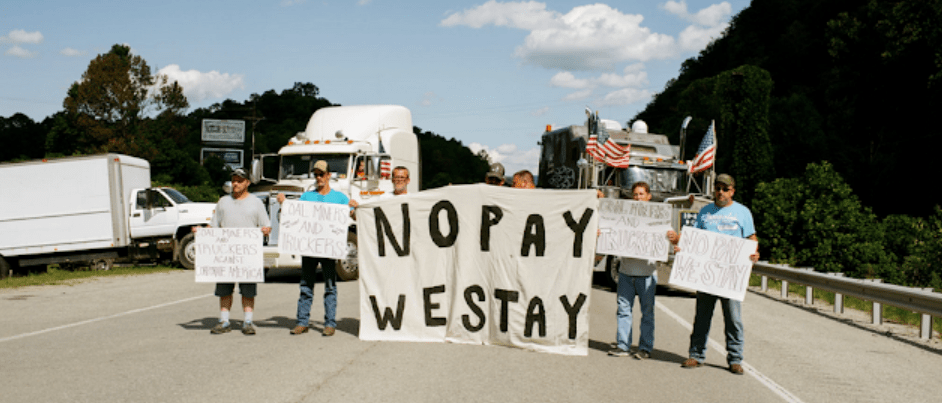By Gabriel Winant
Thirty-five years ago last month – October 1986 – the giant agricultural equipment manufacturer John Deere locked out striking members of the United Auto Workers. (UAW) This event, following shortly on lockouts of meatpackers by Hormel Foods and steelworkers by USX (formerly and today again US Steel) signalled that the punishing waves of layoffs and plant closures of the early 1980s had not satisfied capital’s appetite for working-class blood.
In 1959, the year of the previous nationwide steel strike, over half a million workers had walked out. By the time of the defensive action at USX in 1986, there were only 20,000 workers left to do so.
With manufacturing under severe profitability pressures, collective bargaining in the 1980s and 1990s became an orgy of so-called ‘givebacks’ – contract concessions that would have been unthinkable at almost any point in the previous half-century. The UAW, like much of the US labour movement, put up a fight, but eventually begged off. ‘What do you do?’ asked a union official. ‘You can’t control the actions of management.’ In February 1987, both UAW members at John Deere and steelworkers at USX trudged back to work, having accepted a deal with no wage increases in the first case and outright wage cuts in the second – both in return for job security commitments.
The bleeding went on. In 1997 the UAW signed a contract with John Deere that again gave no hourly raises and instituted a two-tier system, with decreased wage rates for new hires. Such structures proliferated across collective bargaining agreements as unions limped into the neoliberal era – evidently the price of survival for a battered labour movement hunted by Republicans and unaided by Democrats.
Rejection of second agreement
This month, the UAW settled with John Deere after five weeks on strike, an action launched when the membership rejected an agreement negotiated by union leadership, and renewed after two weeks on strike with the rejection of a second tentative agreement. The 10,000 John Deere workers finally agreed to the company’s offer, overall very similar to the rejected second agreement: a 10% wage increase in the first year, 5% in the third and fifth years, and 3% lump sums in the second, fourth, and sixth years, along with an immediate bonus of $8,500. While the settlement is clearly a victory marking the end of the concessionary years, it does not uproot the hated tier system that divides the workforce, nor get wages back on their pre-1997 trend.

Along with a dozen or two other recent, ongoing or potential labour actions, the John Deere strike forms what has been dubbed ‘Striketober’ – an unexpected revival in working-class militancy in its classic form. Unlike the wave of teachers’ strikes in 2018-2019 known as the ‘Red for Ed’ movement, the current episode spans all sectors: nurses recently settled a strike in Buffalo, coal miners are on the line in Alabama, hospital workers in the Kaiser Permanente health care chain on the west coast, musicians in San Antonio, graduate students at Columbia. Tens of thousands of Hollywood’s technical workers authorized a strike with 99% vote at 90% turnout, and only narrowly ratified a settlement instead by means of arcane electoral rules. Numerous others wait in the wings or have recently settled.
Increased working class confidence
Such militancy represents the sharp, organized tip of a more diffuse phenomenon, the so-called ‘Great Resignation’: the quit rate has been driven to historical highs by the conjunctural combination of accumulated outrage at the workplace brutalities of the pandemic, plus increased working-class confidence and labour market leverage due to the emergency expansions of the social safety net and the recovery of employment.
Even as unemployment falls toward 4%, the labour force participation rate remains two points lower than before the pandemic, and does not appear to be rising: in other words, the uptick in wages and downtick in unemployment are not drawing more people back into labour markets who have decided or been compelled to exit them over the past two years.
This fact has lent the current episode of refusal its generally atomized shape, due to the low level of organization across the working class – what would once have been strike action appears today more often in the form of unfilled vacancies. But it also helps to explain the trans-sectoral character of the organized workplace activity, particularly the centrality of overwork in many strikes, as employers calculate that it is preferable to force 12-hour shifts than to raise wages sufficiently to lure nonparticipants back into the workforce.
The weakness of much of the labour movement also has paradoxically created room for the ideological left to establish footholds, around which scatterings of militants may emerge – a subtle shift that deserves some credit for rising militancy across sectors. Once-marginal activist formations have proven able to gain ground within union organizations in teaching, nursing and across the culture industries; a democracy movement has emerged within the United Auto Workers, a union which has become a shadow of its former self, plagued at the top by corruption and incompetence. Most significantly, the rank-and-file reform slate recently captured control of the Teamsters away from the Hoffa dynasty in a landslide election.

While mainly due to the weakness of traditional conservative leadership, this is also in part a superstructural phenomenon. For example, rising militancy among journalists has caused a recovery in labour journalism, in turn magnifying the quantity and quality of images and narratives of labour struggle. Discursively, the labour movement commands attention once again from a broad liberal public that shunned it for decades, and while the significance of this development is difficult to estimate with any precision, its effects appear to be widespread in the current moment: unions receive more favourable responses in public opinion polling, and professional organizers across much of the country have reported anecdotally a significant increase in direct contact from disgruntled workers.
Minimum-wage jobs going unfilled
I was born the month of the last John Deere strike; I turned 35 during the recent one. Minimum-wage jobs going unfilled, assembly plant workers voting down contracts – these are new marvels in my lifetime. While it is possible to make conjunctural sense of this episode, the true challenge is to search out a strategic path by which such intensified engagement along what remains an exceedingly narrow front might widen into something more. The present strike wave, such as it is, is a matter of only tens of thousands, not the millions of earlier episodes of US labour history.
Workers in the United States have been taught a hard lesson for years that collective action only yields punishment. The effect, over the past generation, has been two-sided, shearing apart the working class along its seams of organization and relative security: with union density down to 10%, union members look out on the millions all around who would gladly do their job for less and become resigned to ineffectual leadership and concessionary bargaining; the unorganized 90% see the inability of unions to deliver, and can make out little reason why they should say yes if an organizer ever comes knocking.
Over the past 35 years, labour’s technicians have tried every trick to get the wheels turning again. They installed new leadership, as when John Sweeney triumphed in the AFL-CIO’s first-ever contested presidential election in 1996, running on a promise to reinvigorate the federation’s organizing capacity and renew its taste for confrontation. They developed the so-called ‘comprehensive campaign’, a method for seeking leverage on employers by means other than direct economic power – most famously in the Justice for Janitors campaign of the late 1990s. They launched modest political adventures, founding groups such as the short-lived Labor Party, New York’s Working Families Party, and the Los Angeles Alliance for a New Economy.
They engaged in mergers and divorces, combining unions and spinning off new umbrella organizations – most prominently the new federation Change to Win, formed by AFL-CIO breakaways in 2005. They launched major organizing campaigns in sectors from higher education to hospitals to hotels to Southern auto assembly plants. Some of these initiatives counted major successes, some degenerated into fiascos, but none generated movement on the scale of the class as a whole, or even a significant fraction. (The teachers’ strikes, arguably the only exception, occurred almost entirely as an organic expression of rank-and-file militancy and socialist leadership rather than any kind of leadership stratagem.)
Stagflation in the 1970s
What is the nature of the present fragmentation of the US working class? Paul Samuelson, high priest of the post-war neoclassical synthesis in economics, once speculated that the American stagflation problem of the 1970s would only admit a Chilean-style macroeconomic resolution at the point of a gun. An orthodox Keynesian, Samuelson – coiner of the portmanteau ‘stagflation’, uncle of Larry Summers – conceded that the Chicago Boys indeed had a solution that could tame inflation, but objected that such an exploit would require a ‘fascist political state’.

Looking back on four decades of neoliberalism, we might say that, in certain respects, Samuelson’s hyperbole contained a kernel of prophecy. Certainly, there existed ample precedent in US history for such a campaign of repression, marking neoliberalism as more continuous with the country’s tradition of coerced labour than whatever novelty Samuelson imagined.
Nonetheless, what came after 1979 cannot be understood in narrowly economic terms: the smashing of the labour movement was only the most targeted blow. Punishment rained down indiscriminately on the class as a whole, through political means as well as in industrial relations.
The first waves of mass industrial layoffs triggered a downward cascade in the labour market – the context in which industrial unions first agreed to concessionary contracts. Millions of individuals either relented to lower-wage work than they had accepted previously, or exited the labour market entirely and were thrown back onto family, the illicit and informal economy or the state for their survival.
A zone of low wages and precarious conditions
A radical increase in household labour supply followed, as women filed into fast-expanding low-wage service economy jobs to compensate for the vanished family wage, even as an assault on the social state continued to transfer the costs and pressures of social reproduction onto them. Largely, moreover, they joined sectors of the labour market already fenced off institutionally as a zone of low wages and precarious working conditions, particularly in what has come to be called the ‘care economy’, which accounted for 77% of all low-wage job growth for women between 1983 and 2007, as Rachel Dwyer shows.
Punitive social policy further eroded proletarian room for manoeuvre. After over a decade of state-level erosion of income support for the poor, Bill Clinton’s welfare reform pushed millions into the bottom of the labour market and, as Melinda Cooper observes, granted fathers automatic custody rights to children regardless of prior relationship – in effect terrorizing poor mothers off the welfare rolls and into minimum-wage work. If this were not enough, the apparatus of policing and imprisonment underwent its extreme metastasis in this period – not precisely what Samuelson imagined as the Chilean solution, but close enough.
Already, global competitive conditions and weakening labour law gave potency to managers’ threats of plant closure or subcontracted work. Even for organized workers, employers were equipped for an increasingly asymmetrical conflict, armed with the power to outsource their jobs or to permanently replace them during strikes.
The full chain of implications of this power has grown as the surrounding labour market and social policy environment has become increasingly hostile: the power to permanently replace strikers or outsource positions became the power to push workers toward the unliveable minimum wage, throw them back into abusive relationships, and toss their children into cells.
Expanding service economy
There is no need to lock up trade union leaders themselves if you can instead intimidate their members with the threat of criminalized unemployment – if walking out of the factory gates for the last time means walking into the jaws of the jailor. The form of struggle that results from this punitive dimension of the American class system is, obviously, racialized, and occurs more in the streets and prisons than in the workplaces.

Those parts of the expanding service economy shielded economically against capital flight are contained by other barriers, no less potent. Either because they enact labour processes that cannot be relocated due to the necessity of direct human interaction, or because they carry out functions of social importance that attract state support, workers in food service and hospitality, health care, child care and education are not buffeted by the same forces at play in much of the shrunken manufacturing sector.
By the same token, however, the service industries are characterized by stagnant productivity, which presses down wages systematically and constrains workers’ leverage, in turn inducing employers to decompose the employment relation itself in order to hold labour costs down.
Such constraints impel workers to engage in political contestation of the social wage as the medium for their own industrial conflicts – as when teachers struggle over classroom sizes, nurses over staffing levels, or Uber drivers over the legal definition of employment. To some degree the productivity constraint has in this way also generated political potentiality, as workers in such circumstances discover they can only win economic gains on the political field, not in industrial conflict alone, and therefore must construct coalitions sufficient to engage broader policy questions – a strategy the labour movement has begun to explore under the name ‘Bargaining for the Common Good.’
The recovery of the labour market from the pandemic’s damage – renewing the belated and warped recovery from the prior crash in 2008 – has stimulated renewal of working-class militancy within the narrow confines of the organized zones, aided by temporary and partial expansions of the social safety net. But this stimulus is unlikely to translate directly into any kind of broader class unity at the social level or a renewal of class polarization within the political sphere, because it arrives in a working class so badly divided by forty years of defeats.
Its stops and starts lay down historical deposits
Class formation, as Adam Przeworski observed long ago, is a discontinuous process. Its stops and starts lay down historical deposits that form into new conjunctures upon which disparate proletarian elements must again attempt to compose themselves, in the process he describes as ‘struggles about class’, which precede class struggles. ‘In each successive historical conjuncture, some carriers of the relations of production are organized as such, some are not organized in any manner, and some appear in struggles about class organization in forms that do not correspond in one-to-one manner to places occupied in even a broadly conceived system of production.’ The modest but noticeable rediscovery of workplace militancy in the organized rump of the US working class has occurred amid precisely such a discontinuity.
Classically it would have been the task not of the labour movement but of the socialist movement to bring into contact with one another the various struggling fragments – those who are organized as carriers of the relations of production, those not organized in any manner, and those engaged in struggles that do not correspond to any broadly conceived system of production, in Przeworski’s terms.
The promising recovery of American socialism in the past decade is not to be made light of, but it too represents a distinct and delimited social stratum – the frustrated young professionals – and its primary points of encounter and affiliation with the broader working class have been in the electoral sphere rather than the more intimate zones of the social and economic.
This current strike wave, then will almost certainly ebb rather than accumulate the way the unrest of the early 1930s did. But even after it recedes, we will be able to see the pools it leaves behind – reservoirs of solidarity, consisting of material victories and new political experiences. These will occupy more of the terrain next year than they did last year; they will be, if still distinct, nearer to one another – and its examples nearer to hand.
From New Left Review. The original can be found here.



